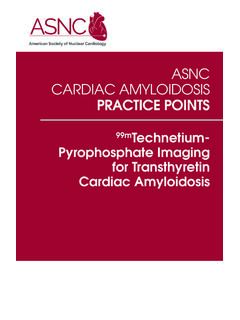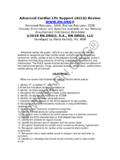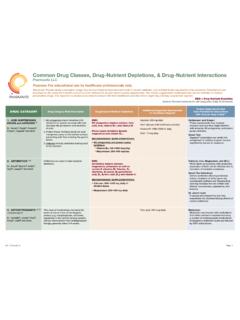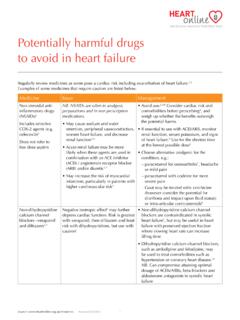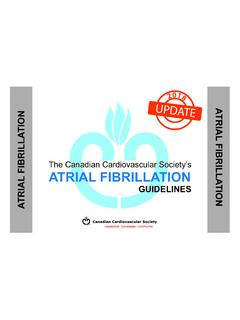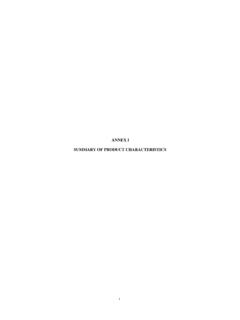Transcription of Imaging Guidelines for Nuclear Cardiology Procedures ...
1 ASNC Imaging Guidelines FOR Nuclear . Cardiology Procedures . Stress protocols and tracers Milena J. Henzlova, MD,a Manuel D. Cerqueira, MD,b Christopher L. Hansen, MD,c Raymond Taillefer, MD,d and Siu-Sun Yao, MDe EXERCISE STRESS TEST (a) Patients with an intermediate pretest probability of CAD based on age, gender, and symptoms. Exercise is the preferred stress modality in patients (b) Patients with high-risk factors for CAD ( , who are able to exercise to an adequate workload (at diabetes mellitus, peripheral , or cerebral vascular least 85% of age-adjusted maximal predicted heart rate disease). and five metabolic equivalents). 2. Risk stratification of post-myocardial infarction patients before discharge (submaximal test at Exercise Modalities 4-6 days), and early (symptom-limited at 1.)
2 Treadmill exercise is the most widely used stress 14-21 days) or late (symptom-limited at 3-6 weeks). modality. Several treadmill exercise protocols are after discharge. described which differ in the speed and grade of 3. Risk stratification of patients with chronic stable treadmill inclination and may be more appropriate for CAD into a low-risk category that can be managed specific patient populations. The Bruce and modified medically or into a high-risk category that should be Bruce protocosls are the most widely used exercise considered for coronary revascularization. protocols. 4. Risk stratification of low-risk acute coronary syn- 2. Upright bicycle exercise is commonly used in drome patients (without active ischemia and/or heart Europe. This is preferable if dynamic first-pass failure 6-12 hours after presentation) and of inter- Imaging is planned during exercise.
3 Supine or semi- mediate-risk acute coronary syndrome patients supine exercise is relatively suboptimal and should 1-3 days after presentation (without active ischemia only be used while performing exercise radionuclide and/or heart failure symptoms). angiocardiography. 5. Risk stratification before noncardiac surgery in patients with known CAD or those with high-risk factors for CAD. Indications 6. To evaluate the efficacy of therapeutic interventions (anti-ischemic drug therapy or coronary revascular- Indications for an exercise stress test are: ization) and in tracking subsequent risk based on 1. Detection of obstructive coronary artery disease serial changes in myocardial perfusion in patients (CAD) in the following: with known CAD. Absolute Contraindications From the Mount Sinai Medical Center,a New York, NY; Cleveland Clinic Foundation,b Cleveland, OH; Jefferson Heart Institute,c Phi- Absolute contraindications for exercise stress test- ladelphia, PA; Centre Hospitalier de lo Universite de Montreal,d St.
4 Ing include: Jean-sur-Richelieu, QC, Canada and St. Lukeo s-Roosevelt Hospi- tal,e Jericho, NY. 1. High-risk unstable angina. However, patients with Approved by the American Society of Nuclear Cardiology Board of chest pain syndromes at presentation, who are Directors on June 24, 2008. Last updated on January 16, 2009. Unless reaffirmed, retired or amended by express action of the Board otherwise stable and pain-free, can undergo exer- of Directors of the American Society of Nuclear Cardiology , this cise stress testing. guideline shall expire as of March 2014. 2. Decompensated or inadequately controlled conges- Reprint requests: Milena J. Henzlova, MD, Mount Sinai Medical tive heart failure. Center, New York, NY. 3. Uncontrolled hypertension (blood pressure [200/.)]
5 J Nucl Cardiol 1071-3581/$ 110 mm Hg). Copyright 2009 by the American Society of Nuclear Cardiology . 4. Uncontrolled cardiac arrhythmias (causing symp- toms or hemodynamic compromise). Henzlova et al Journal of Nuclear Cardiology Stress Protocols and Tracers exercise-induced ST-segment changes have resolved. 5. Severe symptomatic aortic stenosis. A 12-lead electrocardiogram should be obtained at 6. Acute pulmonary embolism. every stage of exercise, at peak exercise, and at the 7. Acute myocarditis or pericarditis. termination or recovery phase. 8. Acute aortic dissection. 4. The heart rate and blood pressure should be recorded 9. Severe pulmonary hypertension. at least every 3 minutes during exercise, at peak 10. Acute myocardial infarction (\4 days). exercise, and for at least 5 minutes into the recovery 11.
6 Acutely ill for any reason. phase. 5. All exercise tests should be symptom-limited. Achievement of 85% of maximum, age-adjusted, Relative Contraindications predicted heart rate is not an indication for Relative contraindications for exercise stress testing termination of the test. include: 6. The radiopharmaceutical should be injected as close to peak exercise as possible. Patients should be 1. Known left main coronary artery stenosis. encouraged to exercise for at least 1 minute after the 2. Moderate aortic stenosis. radiotracer injection. 3. Hypertrophic obstructive cardiomyopathy or other 7. In patients who cannot exercise adequately and are forms of outflow tract obstruction. being referred for a diagnostic stress test the patients 4. Significant tachyarrhythmias or bradyarrhythmias.
7 May be considered for conversion to a pharmacologic 5. High-degree atrioventricular (AV) block. stress test. 6. Electrolyte abnormalities. 8. Blood pressure medication(s) with antianginal proper- 7. Mental or physical impairment leading to inability to ties (b-blocker, calcium channel blocker, and exercise adequately. nitrates) will lower the diagnostic accuracy of a 8. If combined with Imaging , patients with complete stress test. Generally, discontinuation of these medi- left bundle branch block (LBBB), permanent pace- cines may be left to the discretion of the referring makers, and ventricular pre-excitation (Wolff- physician. Parkinson-White syndrome) should preferentially undergo pharmacologic vasodilator stress test (not dobutamine stress test). Indications for Early Termination of Exercise Limitations Indications for early termination of exercise include: Exercise stress testing has a lower diagnostic value in patients who cannot achieve an adequate heart rate 1.
8 Moderate-to-severe angina pectoris. and blood pressure response due to a noncardiac phys- 2. Marked dyspnea or fatigue. ical limitation such as pulmonary, peripheral vascular, 3. Ataxia, dizziness, or near-syncope. or musculoskeletal abnormalities or due to lack of 4. Signs of poor perfusion (cyanosis and pallor). motivation. These patients should be considered for 5. Patient's request to terminate the test. pharmacologic stress with myocardial perfusion 6. Excessive ST-segment depression ([2 mm). Imaging . 7. ST elevation ([1 mm) in leads without diagnostic Q waves (except for leads V1 or aVR). 8. Sustained supraventricular or ventricular tachycardia. Procedure 9. Development of LBBB or intraventricular conduc- 1. Patient preparation: Nothing to eat 2 hours before the tion delay that cannot be distinguished from test.]]
9 Patients scheduled for later in the morning may ventricular tachycardia. have a very light (cereal, fruit) breakfast. 10. Drop in systolic blood pressure of[10 mm Hg from 2. A large-bore (18- to 20-gauge) intravenous (IV) baseline, despite an increase in workload, when cannula should be inserted for radiopharmaceutical accompanied by other evidence of ischemia. injection during exercise. 11. Hypertensive response (systolic blood pressure 3. The electrocardiogram should be monitored contin- [250 mm Hg and/or diastolic pressure [115 mm uously during the exercise test and for at least Hg). 5 minutes into the recovery phase or until the resting 12. Technical difficulties in monitoring the electrocar- heart rate is \100 beats/minute and/or dynamic diogram or systolic blood pressure.]]]
10 Journal of Nuclear Cardiology Henzlova et al Stress Protocols and Tracers PHARMACOLOGIC VASODILATOR STRESS effects are flushing (35-40%), chest pain (25-30%), dyspnea (20%), dizziness (7%), nausea (5%), and There are currently three vasodilator agents avail- symptomatic hypotension (5%). Chest pain is non- able: dipyridamole, adenosine and, most recently specific and is not necessarily indicative of the approved, regadenoson. They all work by producing presence of CAD. stimulation of A2A receptors. Methylxanthines (caf- 2. AV block occurs in approximately of cases. feine, theophylline, and theobromine) are competitive However, the incidence of second-degree AV block inhibitors of this effect which requires withholding is only 4%, and that of complete heart block is less methylxanthines prior to testing and permits the reversal than 1%.
